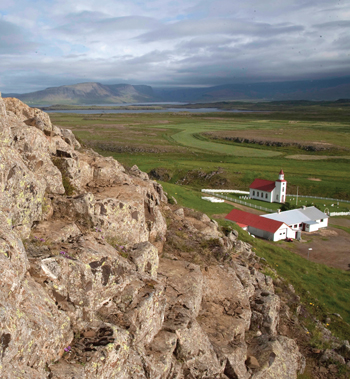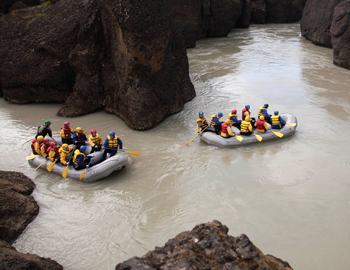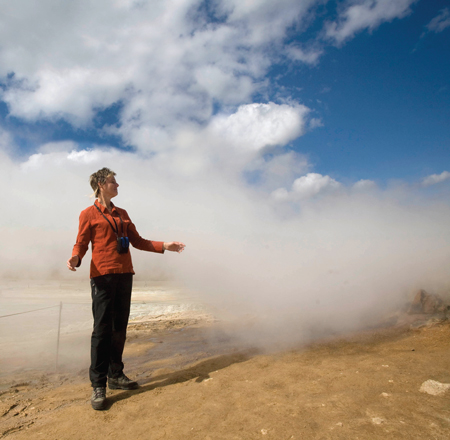When Jules Verne plotted his 1864 adventure novel Journey to the Center of the Earth, he chose Iceland as a setting. This mystical island just below the Arctic Circle, much of its surface covered in a blanket of snow and ice, much of its core a fiery inferno, was legendary even in Verne’s time—known for explosive volcanoes, steaming red lava fields and towering geysers.
I launched my midsummer foray into Iceland’s “wild side” from the same place as Verne’s fictional characters — in the shadow of the extinct volcano Snaefellsjökull (“snow mountain”).
My fellow travelers and I—16 Americans and our Icelandic guide—arrived at the dormant glacier on the Snaefellsnes Peninsula after a 60-mile drive from Reykjavik over narrow rural roads built on beds of crushed lava. Even in our comfy 20-passenger van, the ride was rough.
En route, we passed through the Deildartunguhver thermal area, where steam rises from everywhere — streams, farmlands, even the shoulders along the road. For two days we hiked the coastline over the Budir lava field, seeing colonies of thousands of seabirds and pastures filled with the famed Icelandic horses first brought here by the island’s Nordic settlers 1,000 years ago.
As a respite from the hiking, we visited a shark farm to taste hakarl, an Icelandic seafood treat made of aged flesh from the ocean predator. We washed down the delicacy with a potato-based coriander-flavored spirit named Black Death.
 While on the peninsula, we stayed in Stykkisholmur, a ferry port and harbor for the local fishing fleet, protected by a bluff topped with a lighthouse. The town’s historic fisheries house seafood restaurants and a Volcano Museum. The next leg of the journey was a 200-mile drive to Akureyri (Iceland’s “second city,” with a population of 17,000), which sits at the base of a fjord 60 miles from the Arctic Circle. Our itinerary took us to a reconstructed sod house on the site where medieval Viking explorer Erik the Red once lived. It also was the childhood home of his mariner son Leifur Eriksson, who is said to have reached North America 600 years before the Mayflower.
While on the peninsula, we stayed in Stykkisholmur, a ferry port and harbor for the local fishing fleet, protected by a bluff topped with a lighthouse. The town’s historic fisheries house seafood restaurants and a Volcano Museum. The next leg of the journey was a 200-mile drive to Akureyri (Iceland’s “second city,” with a population of 17,000), which sits at the base of a fjord 60 miles from the Arctic Circle. Our itinerary took us to a reconstructed sod house on the site where medieval Viking explorer Erik the Red once lived. It also was the childhood home of his mariner son Leifur Eriksson, who is said to have reached North America 600 years before the Mayflower.
Arriving in Akureyri, we stretched our legs with a stroll along the port’s old town pedestrian street, lined with shops and cafes characterized by corrugated metal siding and boxes of colorful petunias.
Akureyri was our base camp for two days of exploration. First we were off to the spectacular volcanic area that surrounds Lake Myvatn, an area of relentless tectonic stress and fantastic geologic wonders. NASA chose this barren landscape to train the Apollo 11 astronauts for their historic 1969 moon walk.
As we approached the lake, towering plumes of mist accented by sparkling rainbows filled the sky. We had arrived at Goðafoss Falls (“falls of the gods”). Here, in 1000, the speaker of the Icelandic parliament threw his pagan Nordic idols into the waters and declared Iceland a Christian land.
Farther up the road, we stopped at Hverarönd, a smoking clay field the size of several sports stadiums, alive with boiling steam vents, mud pits and a sulfurous fog ripe with a stench like rotten eggs. The ground, fragile as a pizza crust, bubbles like boiling water. Raised walks and roped corridors provide safe passage through this dangerous maze.
The next day we drove to Húsavik on the shores of Skjálfandi (“shivering fjord”). A onetime whaling town, Húsavik today is Iceland’s whale-watching capital, launching point for tours in search of the 90-foot-long Icelandic blue whale, one of 24 whale species that frequent the local waters. Our vessel was the 69-foot oaken-hulled Nattafri. After donning precautionary storm gear, we set out on a two-and-a-half-hour voyage in what turned out to be calm seas providing a dozen close-up whale sightings.
 We hopscotched back to Reykjavik for a day of touring geothermal facilities, then made our way 40 miles east to the southern city of Selfoss, base for the final leg of our journey. In the morning, we trekked through a deep canyon to the 20-story Seljalandsfoss Falls, which plummet over a wide ridge. A pathway took us below the ridge where we could view the torrent from underneath and behind.
We hopscotched back to Reykjavik for a day of touring geothermal facilities, then made our way 40 miles east to the southern city of Selfoss, base for the final leg of our journey. In the morning, we trekked through a deep canyon to the 20-story Seljalandsfoss Falls, which plummet over a wide ridge. A pathway took us below the ridge where we could view the torrent from underneath and behind.
Next, it was south to Vik, where we lunched on local wild salmon in a hostel that overlooked Vik’s spectacular crescent-shaped black volcanic beach (often named one of the world’s top 10 beaches), sea caves and ocean bluffs decorated by huge pillars of basalt. Afterward, we strapped on ice spikes for a two-hour hike along the terminal moraine of the Sólheimajökull Glacier.
The next day was also an active one, beginning with a bouncy three-hour paddle trip down the Class II rapids of the glacier-fed Hvítá River. At one point, our 25-year-old guide led us on a steep climb to the top of the canyon. Standing on a rocky promontory four stories above the river, he invited us to join him in a dive into the calm water below. Casually, he stepped off the ledge and moments later pierced the water below like an arrow. A few of my fellow travelers took the plunge. I chose to scramble back down the cliff.
There was enough time in the day to visit Iceland’s most famous geysers: Geysir (from which all geysers of the world take their name) and Stokkur. Geysir began spewing 20-story spouts in 1294, but it is now dormant. Stokkur, though, still sends up scalding 75-foot salutes every six minutes.
Before heading home, I made a pilgrimage to the Blue Lagoon, a sprawling health spa about 25 miles from Reykjavik and a mecca of relief for psoriasis and eczema sufferers. We donned our bathing suits, slathered ourselves with silica mud and immersed ourselves in soothing mineral waters.
On the flight home, I thought of one my first experiences in Iceland—my hike up Helgafell (“holy mountain”) on the same Snaefellsnes Peninsula where Jules Verne set his 19th-century classic. At its tabletop summit (actually just a 250-foot-high outcrop), a three-sided stone enclosure served as a windbreak and a place to take in the 360-degree view of the peninsula’s volcanic peaks and coast.
Local legend holds that a first-time climber of Helgafell will be granted three wishes—but only on three conditions: don’t look back during the climb; don’t speak to anyone on the way to the summit; and never reveal the wishes. I didn’t, I didn’t and I won’t.
If You Go
Summer is the best time to see the most of the island; rural roads are open everywhere; the Midnight Sun shines day and night. Iceland’s now a bargain with its currency devalued by half as a result of the world economic crisis. English is widely spoken. Twelve-day, 10-night escorted tour limited to 16 travelers with air from San Francisco June–August, from $4,095. Overseas Adventure Travel, oattravel.com.


